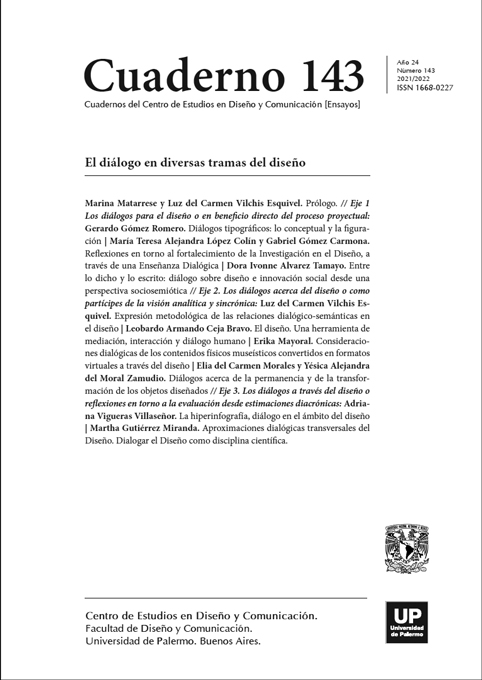El diseño. Una herramienta de mediación, interacción y diálogo humano
Abstract
This text seeks to contribute to the reflection on the interaction given between people througt the designed objects. Underlying this relationship is the mediation contribution that the design has, namely, dialectial. In this sense, reflecting on this implication that design has, is crucial and more so in today’s time. In the same way, it will be essential to analyze the influence and intervention that desing has in all areas of life, influencing the experience, the experience and the varoius ways of life of people, promoting, conditioning and determining ways of life and the ways in which they relate to the environment, so it is important that project disciplines be understood as a conditioning form of human and social behavior. In this context, the existence of a “design literacy” (Lutnæs, 2019) is crucial as an underlying dialogue process, it is a social continuum. Thinking of design as a discipline aimed at training, informing, promoting, articulating, regulating, reordering, re-signifying or reinterpreting decisively contribuyes to the social action involved, providing value and power to the interaction between people. In order for this dialogical process to take place, it is important to keep in mind the context in which these interactions occur, for this, to think of a “semiosphere (Lotman, 1996) of the interactions, it’s an opportunity to analyze the various resulting dialogues between people and what is designed, thus producing a doublé “analogical hermeneutical” process (Beuchot, 2016), the first one given when the designer performs all the actions required and involved to arrive at a design response, the second moment occurs once the design is designed, it’s immersed within the social context, generating an interaction with people.
References
Albano, S., Levit, A., y Rosenberg, L. (2005) Diccionario de semiótica, Buenos Aires, Argentina: Ed. Quadrata.
Antaki, I. (2006) El manual del ciudadano contemporáneo, México: Ed. Booket.
Bajtín, M. (1989) Teoría y estética de la novela, Madrid, España: Ed. Taurus.
Barón, M., y Echavarría, M. (2020) Laboratorio de empatía: indagando principios éticos para la educación en diseño, en Diseña, Agosto 2020, pp. 106-127.
Beuchot, M. (2016) Hechos e interpretaciones. Hacia una hermenéutica analógica. México: Ed. F.C.E.
Berardi, F. (2017) Fenomenología del fin. Sensibilidad y mutación conectiva, Buenos Aires, Argentina: Ed. Caja Negra.
Bravo, Ú., y Bohemia, E. (2020) Alfabetización en Diseño para Todos, en RChD: creación y pensamiento, 5(8). 63-76. DOI: 10.5354/0719-837X.2020.57649.
Ceja. L. (2018) La complejidad dentro del proceso de validación en el diseño. Una expresión subyacente del modelo funcional en Educación, Aplicación e Innovación en Diseño, México: Ed. Qartuppi.
Coronado, G., y Hodge, B. (2017) Metodologías semióticas para análisis de la complejidad, Australia, Ed. Institute for Culture and Society, Western Sydney University.
Escobar, A. (2016) Autonomía y diseño. La realización de lo comunal, Popayú, Colombia: Ed. Universidad de Cauca.
Flusser, V. (2002) Filosofía del diseño, España: Ed. Sintesis.
Freire, P. (2011) La importancia de leer y el proceso de liberación, México: Ed. Siglo XXI.
Freire, P. (2015) Pedagogías de los sueños posibles. Por qué docentes y alumnos necesitan reinventarse en cada momento de la historia. México: Ed. Siglo XXI.
García, R. (2000) El conocimiento en construcción. De las formulaciones de Jean Piaget a la teoría de sistemas complejos, Barcelona, España: Ed. Gedisa.
Han, B., (2018) Hiperculturalidad, España: Ed. Herder.
Latour, B. (2008) Reensamblar lo social. Una introducción a la teoría del actor-red, Buenos Aires, Argentina: Ed. Manantial.
Lotman, I. (1996) La semiosfera I. Semiótica de la cultura y del texto, Valencia, España: Ed. Frónesis Cátedra, Universidad de Valencia.
Luhmann, N. (2007) Introducción a la Teoría de Sistemas, México: Ed. Universidad Iberoamericana.
Lutnæs, E. (2019) Enmarcando el concepto Alfabetización en diseño para un público en general, en Perspectivas de investigación en la era de las Transformaciones, Conferencia de la Academia para la Gestión de la Innovación en el Diseño, Londres, Reino Unido. DOI:10.33114/admin.2019.01.224
Margolin, V. (2005) Las políticas de lo artificial. Ensayos y estudios sobre diseño, México, Ed. Designio.
Meillassoux, Q. (2015) Después de la finitud. Ensayo sobre la necesidad de la contingencia. Buenos Aires, Argentina: Ed. Caja Negra.
Morin, E., (1998) Introducción al pensamiento complejo, España: Ed. Gedisa.
Noë, A. (2010) Fuera de la cabeza, Por qué no somos el cerebro. Y otras lecciones de la biología de la consciencia, Barcelona, Ed: Kairós.
Norman, D. (2005) El diseño emocional, por qué nos gustan (o no) los objetos cotidianos, España: Ed. Paidós.
Simon, H. (1996) The sciences of the artificial [Las ciencias de lo artificial]. USA: Mit. Press, Cambridge, MA.
Souza de Freitas, A. (2015) Prefacio. Pedagogía de los sueños posibles: El arte de volver posible lo imposible en Pedagogías de los sueños posibles. Por qué docentes y alumnos necesitan reinventarse en cada momento de la historia. México: Ed. Siglo XXI.
Vargas, R. y Briede, J. (2020) Alfabetización de Diseño, o el Diseño de Individuos de Postindustria, en RChD: creación y pensamiento, 5(8). 63-76. DOI: 10.5354/0719-837X.2020.57652.
Vygotsky, L. (2015) Pensamiento y lenguaje, México: Ed. Boocket.
Wittgenstein, L. (2008) Investigaciones filosóficas, Barcelona, España: Ed. Crítica.
Wong, W. (1991) Fundamentos del diseño Bi- y Tri-dimensional, Barcelona, España: Ed. Gustavo Gili.
Los autores/as que publiquen en esta revista ceden los derechos de autor y de publicación a "Cuadernos del Centro de Estudios de Diseño y Comunicación", Aceptando el registro de su trabajo bajo una licencia de atribución de Creative Commons, que permite a terceros utilizar lo publicado siempre que de el crédito pertinente a los autores y a esta revista.


